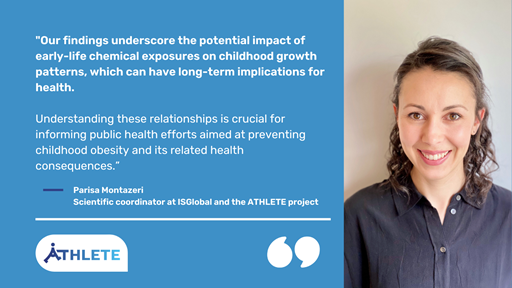
A new study led by researchers from the Barcelona Institute for Global Health (ISGlobal), a partner in the EU-funded ATHLETE research project, has shed light on the influence that endocrine disrupting chemicals (EDCs) can have on children’s growth during their early years. The results, published in Environmental Health Perspectives, show that prenatal exposure to some of these environmental chemicals and their mixtures is linked to accelerated Body Mass Index (BMI) gain from birth to nine years old.

The study, involving 1,911 mother-child pairs from the Project INMA (another research project working with birth cohorts in Spain), focused on assessing exposure to a wide range of endocrine disrupting chemicals (EDCs). These chemicals are found in our diet and in everyday products like plastics, personal care items, and pesticides and include Persistent Organic Pollutants (POPs), perfluoroalkyl substances (PFAS), polychlorinated biphenyls (PCBs), phthalates and phenols (including parabens and bisphenol A).
The research team measured the concentrations of endocrine disrupting chemicals in urine and blood samples collected from pregnant women. Subsequently, they measured the BMI of their children over time. BMI is a measure that combines a child’s height and weight and is commonly used to assess weight status and obesity.
The statistical analysis showed that prenatal exposure to specific POPs, including Hexachlorobenzene (HCB) and Dichlorodiphenyldichloroethylene (DDE), as well as certain PFAS, can significantly alter a child’s BMI trajectory. These alterations are characterised by either lower birth size followed by accelerated BMI gain or higher birth size with accelerated BMI gain.
One of the main novelties of the study is that, in addition to studying individual chemicals, the researchers also conducted a mixture analysis. This involved examining how a combination of different EDCs might impact children’s growth, which offers a more realistic representation of how humans are exposed to EDCs. This approach showed that the mixture of EDCs was associated with an increased risk of children belonging to a trajectory of accelerated increase in BMI, with HCB, DDE and PCBs being the main contributors to this mixture effect.
“Our findings underscore the potential impact of early-life chemical exposures on childhood growth patterns, which can have long-term implications for health. Understanding these relationships is crucial for informing public health efforts aimed at preventing childhood obesity and its related health consequences”, Parisa Montazeri, ISGlobal researcher and first author of the study, commented.
“These revelations are of significant public health interest, as accelerated growth during childhood has been linked to various health issues during childhood and in later life, including obesity, cardiovascular diseases, and diabetes”, says Martine Vrijheid, head of ISGlobal’s programme on Environment and Health over the Lifecourse, ATHLETE coordinator, and senior author of the study.
The study’s authors emphasize the need for more research to assess the health implications of prenatal environmental chemical exposure over the course of a child’s life. Understanding these connections is crucial for informing policies and interventions aimed at reducing the health risks associated with exposure to harmful chemicals during pregnancy.
Exposure to endocrine disrupting chemicals is one of many environmental exposures the ATHLETE project researches to get a holistic understanding of how different forms of pollution can impact health, from pregnancy up to adolescence. This approach to studying environmental pollution, called the Human Exposome, is groundbreaking because it allows researchers to simultaneously explore multiple exposures and their health outcomes. As a result, ATHLETE’s research has the potential to answer key questions about the development of disease and how European policy makers can take preventative action against harmful pollution.
Reference
Parisa Montazeri, Nuria Güil-Oumrait, Sandra Marquez, Lourdes Cirugeda, Andrea Beneito, Mònica Guxens, Aitana Lertxundi, Maria-Jose Lopez-Espinosa, Loreto Santa-Marina, Jordi Sunyer, Maribel Casas, Martine Vrijheid. Prenatal exposure to multiple endocrine disrupting chemicals and childhood BMI trajectories in the INMA cohort study, Environmental Health Perspectives, 107006-11 131(10), October 2023. doi:10.1289/EHP11103